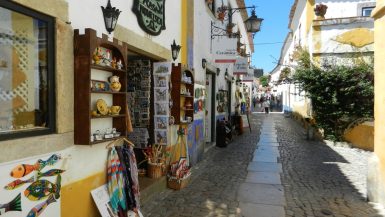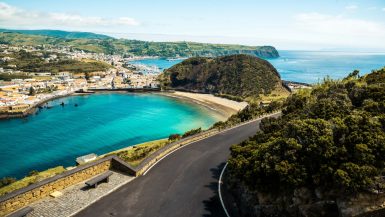
Porto is edgy yet historic; a city filled with characteristic charm, tantalizing cuisine, and stacks of culture. There’s the obvious points of interest – the UNESCO old town, the port and the port cellars, and the nearby Douro Valley. And then there’s the lived-in side, whether that’s a fizzing nightlife scene or the lazy, sun-kissed beach villages to the north and south. So, is Porto worth visiting? Well, it’s an obvious yes from us!
Porto is the second largest city in Portugal. It sits in the far reaches of the north, closer to Spanish Galicia than to Lisbon. For years, it’s been content to let the capital and the Algarve draw the crowds, establishing itself as a bit of an alt hub for creative gastronomy, jazz bars, wine tasting, and less-busy beach life. However, a combo of increased low-cost airline connections to the rest of Europe and Instagram feeds riddled with Porto’s pastel-painted port area has finally shifted the attention, and the town has now risen to become a firm city-break fav.
This guide will delve into the historic center and its surrounding region. The aim? To answer is Porto worth visiting with nine highlights of the city, ranging from the beautiful and atmospheric Ribeira district to the lush winelands and golden-sand beaches that abound nearby. Start packing those bags, folks…
The Ribeira

Porto’s historic center is enough to rival the capital in Lisbon. It’s much smaller than its compadre down south, but there’s a certain grittiness to the place that combines with centuries-old architecture to create somewhere truly wonderful. You’re looking for the district known as Ribeira. The entire thing is now a designated UNESCO World Heritage Site. It clutches the north bank of the Douro River as it flows through the heart of the city, cascading down a steep hill, a multitude of pinks, blues, and saffron shimmering on the various buildings.
Highlights include the old port cellars that line the waterside, though many of the most famous are over the river to the south. Ribeira itself is now anchored on the vibrant walking street of Cais da Ribeira, a forever-bustling run of cafes and bars that fronts the waterside. From there, you should easily be able to reach the following must-see locations.
- Praça da Ribeira – The Ribeira main square, home to gorgeous magenta-painted mansions and lots of tourist offices.
- Luis I Bridge – Porto’s most iconic site, a metalwork bridge, built in the late 19th century under the guiding hand of one Gustave Eiffel (heard the name?).
- Casa do Infante – A historic building dating back to 1394, also the birthplace of revered Portuguese explorer Henry the Navigator.
- Porto Cathedral – Porto Cathedral commands the hill above the Ribeira. It’s a stunning piece of architecture but also the perfect place to take in the whole district at sunset.
Every corner of Ribeira boasts a rich history, showcasing the epitome of Portuguese culture and the past of the Age of Discovery. There are countless local cafés and Portuguese taverns dotted around the winding streets, especially if you delve into the narrow alleys immediately behind Cais da Ribeira or scale the steep sidewalks of Rua das Taipas.
The nightlife

Forget Lisbon, Porto locals do a good job of flying the flag for the northern city when it comes to establishing the nightlife capital of Portugal. Yep, this is one darn hedonistic town, with an after-dark side that can suit a whole range of different travelers. Whether you’re on the hunt for gritty rock bars, refined wine cellars, or chilled beer spots overlooking the Douro, Porto has you covered.
We’d always recommend starting the night at the Jardim do Morro. It’s a pint-sized park draped over a high hill just across from the Porto old town. You can get there by walking the Luis I Bridge (be sure to dodge the trams). Grab a beer or a Douro wine from the local supermarket before you arrive. Oh, and try to get there early, because it’s a local’s favorite and will fill up.
After that, there are a few various nightlife hubs in Porto. They include:
- Vitória – Sleek, noir cocktail bars join with tapas restaurants and microbreweries in this happening part of the city.
- Poveiros – A very vibrant (and cheap) student area that’s got bars that spill onto the main plaza, always extremely busy on weekends and a great crowd.
- Av. de Ramos Pinto – The main Douro walkway on the south side of the river, home to many of the best port cellars and some great open-air bars.
- Ribeira – The old town of Porto has its fair share of nightlife, especially in the form of al fresco cocktail bars hidden under the alcoves just off the riverway.
- Matosinhos – Party by the Atlantic Ocean in stylish beachside bars and surf hostels in this westernmost part of town.
Because it’s easy to get to!

Porto is now one of the most accessible places in Portugal. The local Francisco Sá Carneiro Airport reigns as the second-busiest aviation hub in the country, second only to Lisbon but actually ahead of the Algarve in the south. It’s served by a whole bunch of airlines, including flag-carrying BA and Air France, along with budget carriers like Wizz Air.
However, it’s the arrival of Ryanair that’s really changed the game here. The airport is now a hub for the Euro low-coster, which offers connections to London, Luxembourg, Marrakech, Madrid, Warsaw – the list goes on and on. On top of that, many of the flights here run all year round, meaning Porto is way more accessible than Portugal’s beach destinations in the winter and fall months.
You can also catch a direct train to Porto from Lisbon. It takes about 2.5 hours and whizzes up the spine of the country, making a pitstop in the historic town of Coimbra along the way. Drivers will also be pleased to see that Porto sits right on the E1 motorway that connects the main beach towns along the Silver Coast and even north into Spain.
The stunning architecture

Porto is positively brimming with eye-catching buildings that should please even the most discerning architecture buff. The whole town is a mixture of grand European Baroque, tile-fronted azulejos churches, handsome mansions decorated in patterned ceramics – it’s lovely to behold.
Let’s begin with the Church of St. Ildefonso. Just a stone’s throw from Porto’s buzzing shopping hub, this one’s ornate blue tiles steal the show. They adorn a bold façade with murals that depict episodes from the lives of the saints and stories from the gospels. On the other side of town is the Igreja do Carmo, a twined church with sculpted statues of the saints on the frontispiece and a whole tiled side. Oh, and don’t miss Porto Cathedral, with its Gothic cloisters and Romanesque turrets that date back nearly 1,000 years.
Architecture lovers should also be certain to drop into São Bento railway station. It’s much, much more than just a hub for the locomotives that run in and out of the city. Inside, an azulejo display is made up of a whopping 20,000 individual tiles. It shows scenes from the Battle of Arcos de Valdevez and the Conquest of Ceuta over in Africa. Around that is a glorious building that’s elegantly finished with touches of Beaux-Arts style.
The shopping

Retail therapy buffs won’t be disappointed with Porto. From handmade Azulejo tiles to local ceramics to regional food delicacies and – of course – wine, there’s oodles to buy here. Those combine with a buzzing main town area that also boasts modern shopping malls and all sorts of high-street outlets.
Head over to Rua das Flores, the city’s main shopping district. That’s got family-run stores, restaurants, and cafes that have been serving the great people of Porto for hundreds of years. A simple stroll down the street is enough to overwhelm the senses. There are street entertainers every five meters, coffee-clinking roasteries, and bakeries that issue the scents of custard tarts into the air. Consider dropping into Claus Porto for bespoke Portuguese fragrances, or hit Livraria Chamine da Mota, a rare bookshop that brims with antiques and all sorts.
Shoppers also shouldn’t skip the district of Bolhão. It hosts the biggest urban market in Porto. That’s the place to go for fresh Portuguese tomatoes, salt cod (a local delicacy), Portuguese olives, Douro red wine – you name it. Oh, and the main high street of the city (Rua de Santa Catarina) is right next door, offering shopping malls and fashion outlets galore.
The beaches

Most tourists flock to the enchanting Algarve for their fix of perfect Portuguese beaches. However, Porto has plenty of its own on offer. They’re generally wilder, windier, and more rugged affairs than their compadres in the south, but have oodles of charm. There are two regions on offer. There’s the Silver Coast, running south of Porto for hundreds of clicks, known for its powdery sand and lashing waves. To the north is the Green Coast, where the verdant hills of the Douro River valley creep ever closer to the Atlantic. Both are downright lovely. Our favorite beaches within easy reach of the city are:
- Granja (Silver Coast) – 20 minutes in a train from São Bento with a change at Campanhã station brings you to this lovely beach with its smattering of rock reefs and tide pools and boardwalk bars.
- Espinho (Silver Coast) – Porto’s best surf beach, offering a series of great jetty breaks and plenty of beachside bars.
- Azurara (Green Coast) – About an hour’s drive north of Porto, Azurara is a relaxed, open bay with sand dunes and reliable surf.
- Praia da Congreira (Green Coast) – Relatively unknown Praia da Congreira is a fantastic place for chilled R&R on the shoreline north of Porto.
However, you don’t actually have to venture out of the city to hit the beach. There are some great urban bays in Porto, too. Head over to Matosinhos and you’ll find the urban surf crowd hitting the breaks there. Or, there’s Praia da Madalena on the south side of the rivermouth, with its quieter sands and clusters of rocks.
The wine and port

Wine, wine, and more wine – that’s what you can expect to drink in Porto. The city sits right on the cusp of the incredible Douro Valley, which is one of the most iconic grape-growing regions in the country – nay, Europe. It’s up there with Rioja and Tuscany. AKA, pretty darn famous.
The good news is that taking a trip into the Douro is now a cinch. There are loads of companies that offer guided tasting tours of the region. That means you won’t have to drive yourself and can enjoy all the vinho verde and rich reds you like. The vineyards that we think stand out from the crowd are:
- Quinta de São Bernardo – A relatively small but charming vineyard that’s conveniently close to Porto. They also have luxury rooms and a pool.
- Quinta do Panascal – Take an audio tour of this mainsta vineyard that’s been going since 1992
- Quinta do Seixo – Famous Sandeman vineyard with views of the river.
You’ll also want to set aside some time to taste some port. It’s the most iconic tipple of the city and bears the same name, after all. The place to do that is along the banks of the Douro River in the Ribeira, where the ancient cellars now offer tasting tours run by experts.
The surf

While regions like the Algarve and the World Surfing Reserve of Ericeira tend to be more famous for their waves, the north of Portugal still gets its fair share of swell. The spots here are a bit more unreliable, a touch wilder, and usually a lot less busy, so there are pros and cons for would-be riders in the Porto region.
Head north from the town and you’ll come to the Green Coast. This is the emptiest area of the lot. Waves await at Praia da Azurara and Praia da Apúlia. They’re fickle beach breaks that will often close out on bigger days but rarely get packed to bursting. To the south of the town you can find more famous spots like Esmoriz and Espinho, with the latter offering a sometimes-hollow right hander off its jetty.
But you don’t have to leave Porto to get a fix of surfing. The urban beach of Matosinhos gets some good swell. The crowd is a mix of after-work locals and surf schools, and the waves tend to be either beefy beach breaks or smaller whitewash waves for those learning.
The awesome day trips

Visits here don’t have to be just about the city itself. Porto is a prime gateway to some of the most incredible parts of the country. Everything from award-winning vineyards to shimmering beaches to charming canal towns is on the menu for those willing to hit the trains or rent their own car. Tempted? Be sure to consider the following day outings during your city break:
- The Douro Valley wine region – We’ve already waxed lyrical about just how stunning this region is, and just how fantastic the wine is. We honestly can’t recommend it enough.
- Aveiro – Hailed as Portugal’s answer to Venice, this city of bobbing canal boats and riverside homes is a true charmer. It takes around an hour to reach on direct train.
- Peneda-Gerês National Park – Tucked into the mountains right in the northern reaches of Portugal, the Peneda-Gerês National Park is a land of unexplored waterfalls, pine-scented hiking trails, and glistening wild swimming spots. It takes just over an hour to reach by road.
- Espinho – Spend a day on the beach or join a surf school by heading down to Espinho.
Some of the above can easily be reached by train (Aveiro). Others are better done with your own rental car.
So, is Porto Worth Visiting?

Is Porto worth visiting? It sure is! The second-largest city in Portugal has established itself as a hotspot for all sorts of travelers. It offers stunning architecture that dates back more than 500 years, enthralling UNESCO World Heritage Site areas, fantastic wine and food, and even access to some of the best beaches and surf sports the north of the country can muster. On top of all that, it’s now easier than ever to reach, because oodles of low-cost airlines now jet into Porto Airport and there’s even a direct train link from Lisbon that takes less than 2.5 hours each way.
How many days do I need in Porto?
We think four to seven days is perfect for Porto. There’s certainly enough in this city to fill a whole weekend break and then some. We’d recommend longer trips of up to a week if you’re keen to escape to the Douro Valley for wine tasting and the local beaches for a bit of surfing. If you just want to see the urban sights and sample the nightlife, then three or four days can work.
What’s Porto famous for?
If we had to pick one thing that Porto is most famous for, it would have to be its namesake drink: Port. It’s a type of fortified wine that’s made in cellars along the riverside of the city – a tasting experience is a must when visiting. On top of that, Porto is known for its lovely architecture and Azulejo tiled churches, which you’ll see dotting the city all over.
When’s the best time to visit Porto?
We think the early autumn is the best time to visit Porto. September, specifically, is great. It’s still warm then and rainfall is rare, so you should find that the local beaches are still good bets. On the flip side, the main summer crowds have all returned home and everything from flights to accommodation dips in cost a little.


